Last updated: October 26, 2021
Article
Skagway's Camera Club
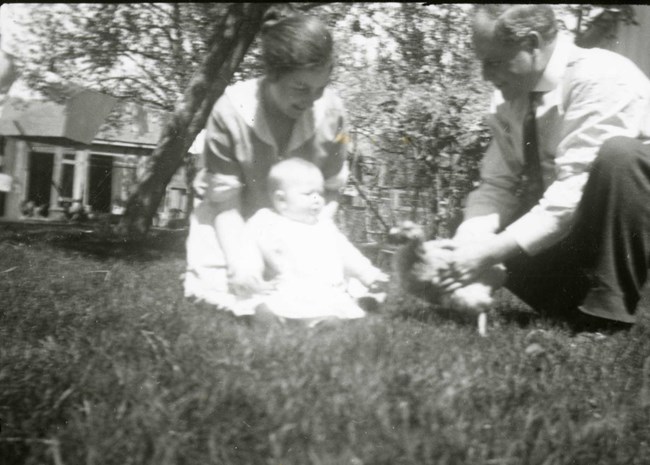
National Park Service, Klondike Gold Rush National Historical Park, Stinebaugh Collection, KLGO 0004.009.001.003jjj.
Capturing the gold rush
Probably everyone interested in local history has seen photos of stampeders climbing the Golden Stairs to the summit of the Chilkoot Pass. They may also have seen shots of Soapy Smith, the work gangs constructing the White Pass & Yukon Route railroad, sobering views of the “Dead Horse Trail,” or sternwheelers spewing smoke over the Yukon River. There’s nothing like a photograph to freeze an otherwise transitory moment in time. For those of us who like history, it’s fortunate there were so many pictures taken during and immediately after the Klondike Gold Rush.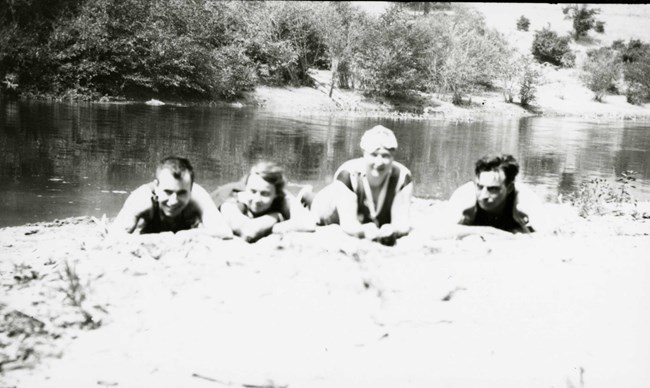
National Park Service, Klondike Gold Rush National Historical Park, Stinebaugh Collection, KLGO 0004.009.001.003zz.
From professionals to amateurs
Many of the best-known gold rush photos were taken by professionals. By the time of the Klondike Gold Rush, however, photography was becoming quite the fad of ordinary people. Much of this was thanks to George Eastman. In 1885, he invented roll film, a boom not just for photographers, but for future movie makers as well. His first inexpensive Kodak camera appeared in 1888. It took round photos 2½-inches in diameter, and carried a film roll large enough to take 100 photos. These earliest cameras were sent back to the factory for film development when the roll was full. The factory would then install a new roll of film in the camera and return the camera and the prints to the owner. The cameras of this era were big and boxy and had non-adjustable lenses. By today’s standards they were pretty primitive. But these cameras and their successors opened the market for less formal “snapshot.” These pictures were not as sharp as those taken by professional photographs, but for over 100 years they have been a record of events taken by the ordinary folk.One of the early Klondike Gold Rush recreational photographers was Mollie Brackett, who lived in Skagway from 1898 to 1899. Years after the gold rush, her photo album from the time period was discovered in the trunk of a repossessed car in southern California. Many of her historically valuable snapshots were published in 1996 in the book entitled One Woman’s Gold Rush.
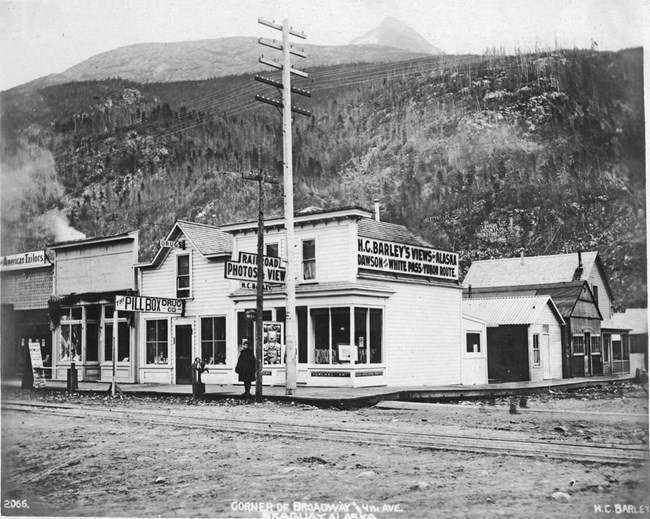
National Park Service, Klondike Gold Rush National Historical Park, Candy Waugaman Collection, KLGO Library Online Archive
Local photographers
Given the growing interest in photography during the late 19th Century, it’s not surprising that a Skagway camera club was formed fairly early in Skagway’s existence. The impetus was a lecture by professional photographer Harrie C. Barley, delivered through Skagway’s Young Men’s Christian Association (Y.M.C.A). Barley probably had some good tales to tell. He was the company photographer for the White Pass & Yukon Route for two years beginning in the spring of 1898. He was noted for his daring, sometimes risking his life to get the perfect railroad construction photograph. He once got too close to a blast which destroyed one of his cameras. He maintained a shop on Fourth Avenue between Broadway and Spring Streets, before moving to a more visible location on the northeast corner of Broadway and Fourth. He also served briefly on the Skagway city council and was a member of the Skagway Elks Lodge. In his March lecture, Barley was described as having a happy, breezy manner, although, according to a March 31, 1900 Daily Alaskan newspaper article “to many in the large audience it must have had a too technical character.” Obviously, though, there were some who were interested, since twenty turned in their names for membership in the newly formed Y.M.C.A. Camera Club. In an April 13th organizational meeting, thirty charter members enrolled. The club voted to equip and furnish a dark room, and to meet weekly.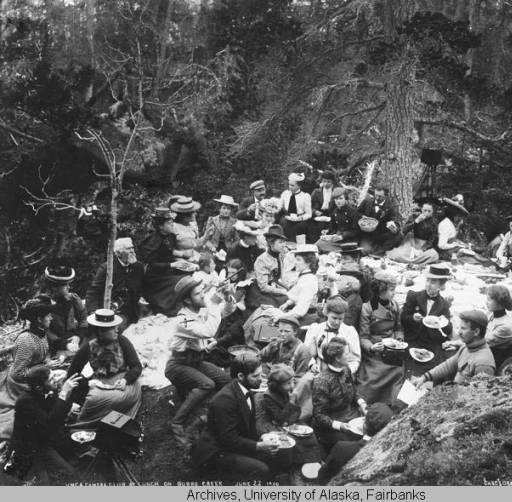
J. Bernard Moore Family Papers, Album #1, UAF-1976-35-35, Archives, University of Alaska Fairbanks
Forming a community
In 1900, Skagway’s population, which may have been over 10,000 two years before, had dwindled to around 3,000. However, many of those remaining were less transient and were looking to join groups. In this era, the Y.M.C.A., the Elks, the Eagles, the Arctic Brotherhood, the Macabees, the Magpies, the Railroad Men’s Athletic Club, not to mention various church groups, were active. One of the most successful groups was initially the Young Men’s Christian Association, which started in a tent during the heady days of the gold rush and quickly drew over 800 members. It had a reading room in a rented building connected to the Presbyterian Church and sponsored lectures and debates. By the middle of 1900 the Y.M.C.A built a gymnasium located behind the church.While exploring the technical aspects of photography, the camera club was also a social organization. This is seen in a picture of a Y.M.C.A. Camera Club picnic at Burro Creek, across from Skagway, on June 22, 1900. There are about 35 participants visible, festively dressed and sitting close, on the ground, passing dishes and eating off what appear to be paper plates. There are several children present and the women outnumber the men. Two tripod-mounted cameras are visible and someone may be holding a box camera. The only person who seems to be shooting anything is holding a pistol instead of a camera. The caption reads, “Doctor Hall (marked with an X) shooting at a squirrel up in the tree.”
The photo was taken by the firm of Case & Draper. Both William H. Case and Hubert H. Draper were active in the club. They opened their Skagway photography studio in February 1898 in a tent with a sign advertising Alaska Views. The partners moved to a two-story frame store on Broadway just north of Fourth Avenue, nearly across from Barley’s Art Studio. Messrs. Case, Draper, and Barley were all involved with the camera club. Case became the first club president and Barley the treasurer. The men probably reasoned that promoting photography was good business.
Through its association with the Y.M.C.A., the camera club got darkroom facilities in the Y.M.C.A.’s rented rooms when they were remodeled following a March 1900 fire. But all was not well with the Y.M.C.A. In August came a controversy about the admission of African American soldiers from Skagway’s Company L. During the next year, the Y.M.C.A struggled to retain members and stay financially afloat, at a time of declining population and an increase in the number of available social and athletic groups. Finally, the Y.M.C.A. shut down its gymnasium in October 1901, due to a lack of membership and funds.
The Y.M.C.A. Camera Club, however, continued to meet during and after this time, although most of the newspaper reports simply refer to it as the Camera Club. With an abundance of under-utilized buildings in town, it appears the club found meeting rooms on State Street by September 1900. Later, club rooms with darkroom facilities were located on Broadway a little south of its intersection with Fourth Avenue. Also, at times the club met at Case & Draper’s store.
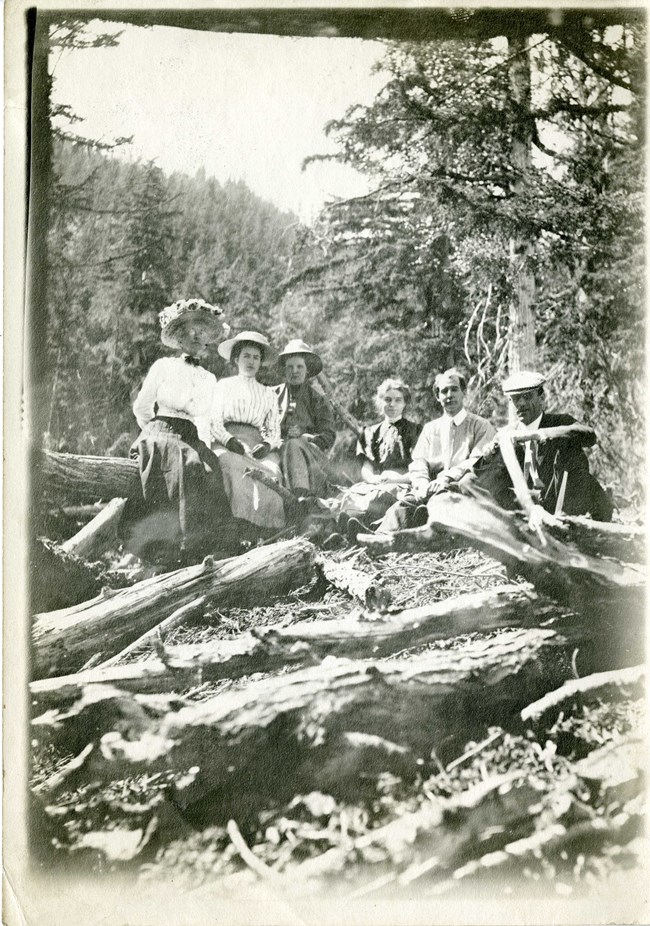
National Park Service, Klondike Gold Rush National Historical Park, Stinebaugh Collection, KLGO 0004.009.001.002.001.0018.
Another photo shows eighteen men and women sitting in the woods picnicking amidst their cameras. The caption reads, “YMCA Camera Club, Lake Dewey, Skagway, Alaska.” On the back of the print is written the participants’ names. This outing was likely covered in the August 26, 1900 edition of the Daily Alaskan “ Twenty-five members of the camera club yesterday scaled the mountain toward Dewey peak. Misses DeGruyter and Emma Sehlbrede, the first of their sex to accomplish the feat, and Dr. Hall and W. A. Reid reached the peak.” Hall we’ve already noted was the mighty squirrel hunter and also served as club president. W. A. Reid was the force behind Alaska’s first Y.M.C.A. in Skagway. He would later work to spread Y.M.C.A.s elsewhere in Alaska and the Yukon.
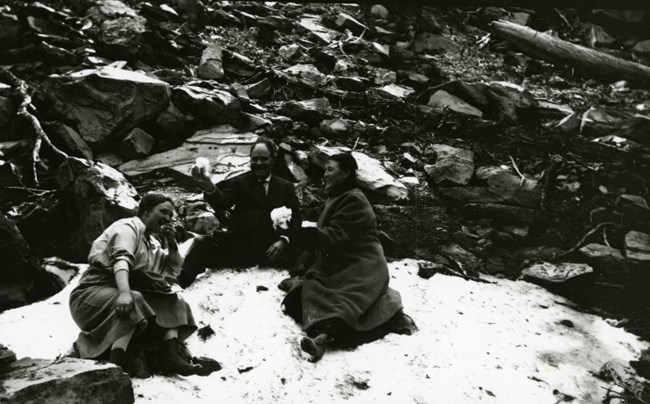
National Park Service, Klondike Gold Rush National Historical Park, Stinebaugh Collection, KLGO 0004.009.001.003ccc
A club endures
The club continued to meet in the colder months, often emphasizing the social over the photographic in its reports. For instance, an October 1900 newspaper item announced that the club was holding a “social” at Case & Draper’s studio and every club member was permitted to invite a guest. The evening’s subject was to be flashlight photography. The club carried on operations in 1901 and again in the winter seemed to emphasize the social over the photographic. A November 10, 1901, Daily Alaskan article reads, “After the transaction of routine business the rest of the evening was passed in social conversation and the club was entertained by the entertainment committee”. The next week the club held a farewell activity for two members, Judge C.A. Sehlbrede and Mrs. W. A. Kirtz. The judge gave the club photos he took during a Yukon trip. The entertainment committee served a luncheon. About twenty were present, including Messrs. Draper, Case, and Mrs. Barley.Later that winter, as reported in the March 2, 1902 issue of the Daily Alaskan, meetings were changed from Fridays to Wednesdays so as not to interfere with the basketball games. In April 1902 the paper reported the club had a “very profitable winter season. The meetings have been regular and well attended and very instructive. Lectures have been agreeably interspersed with social pleasure. The club is now preparing for active summer operations which will be initiated as soon as the mains thaw out that they may have a flow of water in their dark room. There are over a dozen applications for membership which will be considered and acted upon at the next meeting.”
Cheery club meeting reports continued to appear in the newspaper however, there were signs of change. The club’s two-term secretary, Mr. W. W. Shorthill, resigned in May 1902 to go to Treadwell. A planned hike to Glacier Lake was rearranged when only three members showed up in June. In October, long-term President Dr. Hall declined to serve longer, although he continued as secretary.
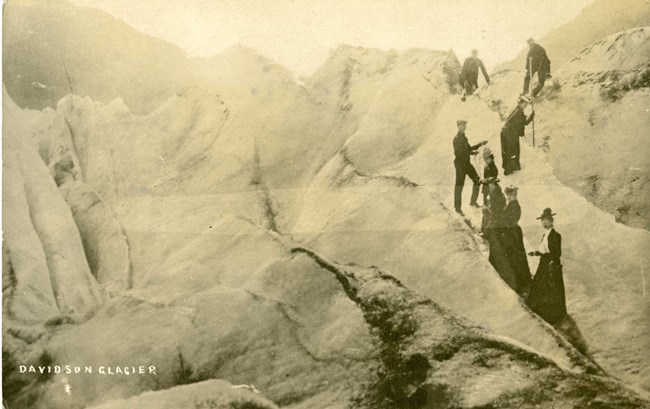
National Park Service, Klondike Gold Rush National Historical Park, Stinebaugh Collection, KLGO 0004.009.001.005f.
The last year of the photography club
During this time there was considerable turmoil in the business community. In the fall of 1902, several stores in town were advertising going-out-of-business sales. One of these was Barley’s Art Studio, which advertised Kodak cameras and photographs for as little as 10 cents. Case & Draper, not to be outdone, advertised “Prices Chopped,” with cameras that sold for $5, now $1.50, or you could purchase an album with 200 views, 50 cent size, for just $2.50. Barley’s closed his store in May 1903 and moved to San Francisco where he died on November 22, 1909. The partners Case and Draper would eventually split up in September 1907. Former club president W. H. Case had received a White Pass & Yukon Route contract in 1901 to photograph the scenery along the route of the railway and connecting steamboats, and may have been living in Whitehorse in 1902. After the break up, Case moved into the old Case & Draper Juneau store in October 1907. Draper continued with the Skagway store, renaming his business Draper & Company and was active in town until his death on August 14, 1913. Case died in Juneau on July 16, 1920.The Camera Club, while outlasting its Y.M.C.A. parent, may have ceased formal operation by the end of 1902 or in early 1903. The specific reason is hard to pinpoint, but an overriding consideration was that Skagway’s population continued its rapid downward spiral. People that were active in the first year of the club had left Skagway and few were coming in to replace them. Also, there were competing groups or activities such as basketball games. Also, it might have been difficult to sustain interest during the colder months, when no outings were planned, and the dark room water supply was frozen.
The Camera Club seems to have sunk with hardly a trace outside newspaper mentions and a few photos of some outings. Presumably, though, for a time it played a role in getting people to take pictures in the Skagway area. That leaves a question: what happened to club member snapshots? Will another Skagway photo album, like that of Mollie Brackett, show up in somebody’s attic or in a garage sale? For those of us who like history, we can only hope.
About this article
This article was researched and written by David Simpson, a 2012 Student Conservation Association Intern at Klondike Gold Rush National Historical Park and originally presented as a radio hitory talk on December 18, 2012. Information was suplied by the following sources:Daily Alaskan articles from Mar. 31, Apr. 14, Aug. 26, Sept. 30, Oct. 14, 1900; Nov. 10, Nov. 16, Nov. 24, Nov. 30, 1901; Mar. 2, Apr. 13, May 10, May 11, May 18, June 1, June 22, Sept. 21 (C&D), Sept. 30 (Barley’s), Oct. 11, 1902
One Woman’s Gold Rush: Snapshots from Mollie Brackett’s Lost Photo Album, 1898-1899. Written by Cynthia Brackett Driscoll and published by Oak Woods Media, Kalamazoo, MI in 1996.
Inflation figures were calculated at www.westegg.com/inflation
